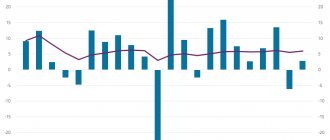The New Year began with a rally in commodity assets. In 2021, gas prices in Asia are breaking records, and the price of coal and iron ore concentrate is going up. Copper is testing the price level of $8,000 per ton, and these are 2013 prices. Gold is 15% from its all-time high. And this is after many food products, primarily oil and grains, went up sharply in the fall. Even the long-suffering oil reached the level of $55 per barrel.
Commodities are becoming popular again - after ten years of being completely ignored by investors. “Hot” money overtook real assets for a very long time. Investors preferred securities - bonds, shares, and real estate. However, the world has run out of paper assets at adequate prices, and it seems that printed money has broken through into commodity markets.
There is one global explanation for the rally that has begun in the market: dollar inflation as a reaction to uncontrolled emissions. This inflation is not (yet) reflected in official statistics. After all, the main manufacturing factory in the world is located outside the dollar zone. The China factor has been keeping inflation in developed countries low for decades. This was noted in his works by long-time Fed Chairman Alan Greenspan.
As a result, prices for goods in stores practically do not rise at any rate of money printing, which leads to suppressed measured inflation. And the industrial sectors practically do not accept new money. But the funds from the huge stimulus packages still have to be absorbed somewhere. And here limited resources come to the fore. First of all, these are stock markets, land and, of course, resources. The fact is that all raw materials are traded in US dollars, and prices have a traditional pattern: if the dollar becomes cheaper, then the goods become more expensive (see Chart 1).
Chart 1 Commodities are countercyclical to the dollar exchange rate
Expert calculations according to Bloomberg data
History of commodity trading
Commodity trading is an ancient profession with a longer history than stock and bond trading. The rise of many empires can be directly attributed to their ability to create complex trading systems and facilitate the exchange of goods. In modern times, goods are still exchanged all over the world. A commodity exchange refers to both the physical location where commodities are traded and the legal entities that have been created to enforce the rules of trading in standardized commodity contracts and related investment products. Some commodity exchanges have merged or gone out of business in recent years. Most exchanges sell several different products, although some specialize in one group. In the US there is the Chicago Mercantile Exchange (CME), the New York Mercantile Exchange (NYMEX), the Intercontinental Exchange (ICE) in Atlanta, Georgia, and the Kansas City Chamber of Commerce. In Europe there is the London Metal Exchange (LME). As the name suggests, the London Metal Exchange deals only in metals.
Firebox with banknotes
However, the main record belongs to gas. The current cold winter shows how thin the LNG market is. The peculiarity of this product is that liquefied gas evaporates at a rate of 1% per day. The evaporated gas increases the pressure in the tanks and is therefore released. Due to self-evaporation, it is impossible to create any large reserves of LNG, unlike the same gas reserves in underground gas storage facilities. As a result, due to supply disruptions, and more often due to the onset of climate winter and increased consumption, sharp shortages of this fuel periodically occur in specific regions, and the existing LNG infrastructure (gas carriers, production facilities, liquefaction and regasification terminals) cannot cope with peak loads . Such crises periodically occur in both Asia and the United States - in markets where underground gas storage facilities have not historically been equipped.
However, this year the situation in Asia was close to collapse. Japan's power grid was unprepared for the harsh winter and persistent weather that in some places reached minus five degrees. As a result, supplies of LNG and coal at Japan's power plants ran out. As a result, electricity prices on exchanges in Japan broke all records. The average daily price on January 12 was 150.25 yen (107 rubles) per kilowatt-hour, the intraday price on the JEPX exchange at peak evening time reached 210 yen (150 rubles) per kilowatt-hour.
The reserves of the country's energy system have been exhausted. Japan's LNG reserves are rapidly running low, with energy companies asking LNG carriers to increase transportation speeds and ports to unload the fuel as quickly as possible. Gas supply prices for February in Japan reached a new historical high, reaching an incredible $1,100 per thousand cubic meters. At this moment, the wholesale price in Europe was 260 dollars per thousand cubic meters, which is a lot compared to the summer 40 dollars per thousand cubic meters.
Of course, Russian companies will profit from this leap. First, eastern coal shipments have increased by 25% in a few weeks. Russian LNG from two projects - Sakhalin-2 and Yamal LNG - went to cover peak demand. The same NovaTEK took unprecedented measures by sending two gas carriers with LNG shipments for Japan along the eastern seas of the Northern Sea Route without icebreaker escort in January (!).
One can argue for a long time that Japan has been methodically destroying its energy system over the past decade: abandoning nuclear power plants and investing in unreliable sources of energy supply in the form of renewable energy sources, unable to cover peak demand. But the main conclusion from the Japanese case is different: if the Japanese did not have money, they would not buy gas at such prices, but would look for other ways to overcome the energy collapse. That is, Japan in the 21st century is drowning thermal power plants with the most accessible resource for it - banknotes.
Features of the commodity market
In the broadest sense, the basic principles of supply and demand are what drive commodity markets. Changes in supply affect demand; low supply means higher prices. Thus, any major disruption to the supply of a commodity, such as a widespread health problem affecting cattle, could result in a sharp jump in otherwise stable and predictable demand for livestock. Global economic development and technological progress can also influence prices. For example, the emergence of China and India as significant manufacturing players (hence requiring greater volumes of industrial metals) has contributed to the decline in the availability of metals such as steel to the rest of the world.
Product types
Traded goods generally fall into four main categories: metals, energy, livestock and meat, and agriculture.
Metals
Metals include gold, silver, platinum and copper. During periods of market volatility or bear markets, some investors may decide to invest in precious metals, especially gold, due to its status as a reliable metal with real transferable value. Investors may also decide to invest in precious metals as a hedge against periods of high inflation or currency devaluation.
Energy
Energy commodities include crude oil, heating oil, natural gas and gasoline. Developments in the global economy and declines in oil production from established oil wells around the world have historically driven up oil prices as demand for energy-related products has increased in tandem with declining oil supplies. Investors who are interested in entering the commodity market in the energy sector should also be aware of how economic downturns, any production shifts caused by the Organization of the Petroleum Exporting Countries (OPEC), and new technological advances in alternative energy sources (wind power, solar energy, biofuels, etc.) that are set to replace crude oil as the main source of energy can have a huge impact on the market prices of commodities in the energy sector.
Livestock and meat
Livestock and meat products include pork, live cattle and feed animals.
Agriculture
Agricultural commodities include corn, soybeans, wheat, rice, cocoa, coffee, cotton and sugar. In the agricultural sector, grains can be very volatile during the summer months or any period of weather-related changes. For investors interested in the agricultural sector, population growth coupled with limited supply of agricultural products may provide opportunities to profit from rising agricultural commodity prices.
Section 1. Terms and definitions
This User Agreement (hereinafter referred to as the Agreement) uses the following terms and definitions:
| Society | Joint Stock Company "St. Petersburg International Commodity Exchange", which is a trade organizer and clearing organization. |
| Website | The official website of the Company on the Internet, which can be accessed at the address , including all pages of the said website containing the designations s-pimex.ru, spimex.ru or spimex.com in their domain name. |
| Exchange information | Information about the progress and results of organized trading held in commodity sections and the Derivatives Market Section of the Company, the obligation to disclose which is provided for by laws, regulations of the Bank of Russia, other regulatory legal acts of the Russian Federation, or which the Company discloses at its discretion by posting on the Site. |
| Indexes | Price indicators calculated by the Company on the basis of information on the progress and results of organized trading held in the commodity sections and the Derivatives Market Section of the Company, information on over-the-counter contracts registered with the Company, as well as other information provided to the Company by third parties. |
| Derived information | Indices, as well as other indicators calculated by the Company on the basis of Exchange information, data obtained from the results of clearing obligations from contracts concluded at organized trading held in commodity sections and the Derivatives Market Section of the Company, Indices and information provided to the Company by third parties. |
| Materials | Texts, audio materials, any images, including any photo, graphic and/or video image, photographs posted on the Site, the copyright holder of which is the Company. |
| Information | Materials, Exchange information, Indices and other Derivative information posted on the Site or provided on the basis of an agreement. |
| Information Services | Services provided by the Company to provide information to interested parties on a reimbursable basis. |
| User | The person using the Site. |
| Spreading | Actions aimed at obtaining information by an unspecified circle of persons or transmitting information to an unspecified circle of persons. |
Using futures to invest in commodities
One way to invest in commodities is through a futures contract. A futures contract is a legal agreement to buy or sell a specific commodity asset at a predetermined price at a specified time in the future. The buyer of a futures contract undertakes to purchase and receive the underlying commodity at the expiration of the futures contract. The seller of a futures contract undertakes to provide and deliver the underlying commodity on the expiration date of the contract. Futures contracts are available for every commodity category. There are typically two types of investors involved in commodity futures markets: commercial or institutional users of commodities and speculative investors.
Types of transactions on TSR
All options for interactions in the commodity market are called transactions:
- Trade in real goods;
- Purchase/sale without a real existing object.
The most commonplace transaction with a real product is the sale of an in-stock item. Forward transactions taking into account the delayed delivery period are more promising for the economy. Conditional transactions stipulate the execution of a specific order by the client. Barter trade is an exchange of goods where ownership is transferred.
In the case where the real object of the transaction does not exist, the most popular are:
- Futures;
- Option.
Using stocks to invest in commodities
Many investors who are interested in entering the market for a particular product will invest in shares of companies that are somehow related to the product. For example, investors interested in the oil industry may invest in drilling companies, oil refineries, tanker companies, or diversified oil companies. For those interested in the gold sector, there are options for buying shares in mining companies, smelters, refineries or any firm that deals in bullion. Stocks are generally considered to be less subject to volatile price fluctuations than futures contracts. Stocks can be easier to buy, hold, trade and track. You can also narrow down your investment to a specific sector. Of course, investors need to do some research to ensure that a particular company is both a good investment and a good product.











